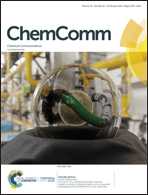Computational and experimental studies on the index of antiaromaticity for 4n π-systems (n ≥ 2)†
Abstract
A linear correlation between nucleus-independent chemical shift (NICS) and relative hardness for various sizes of antiaromatic 4n π-systems (n ≥ 2) was revealed with HF computations using the gauge-including atomic orbital (GIAO) and time-dependent (TD) methods. Based on this finding, a method to evaluate the relative hardness of 4n π-systems (n ≥ 2) as a new experimental measure of antiaromaticity has been developed.



 Please wait while we load your content...
Please wait while we load your content...